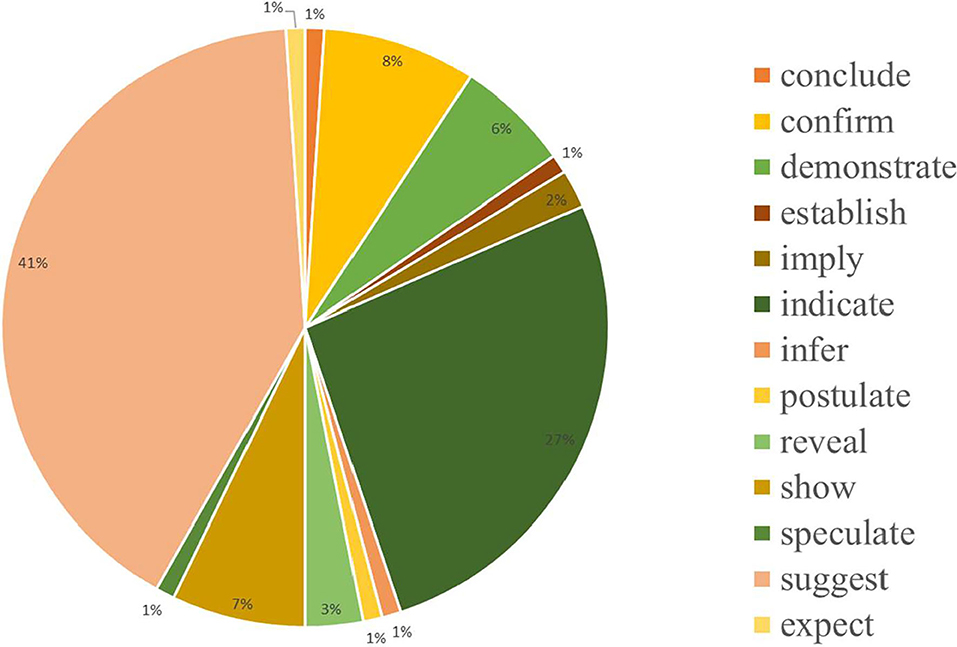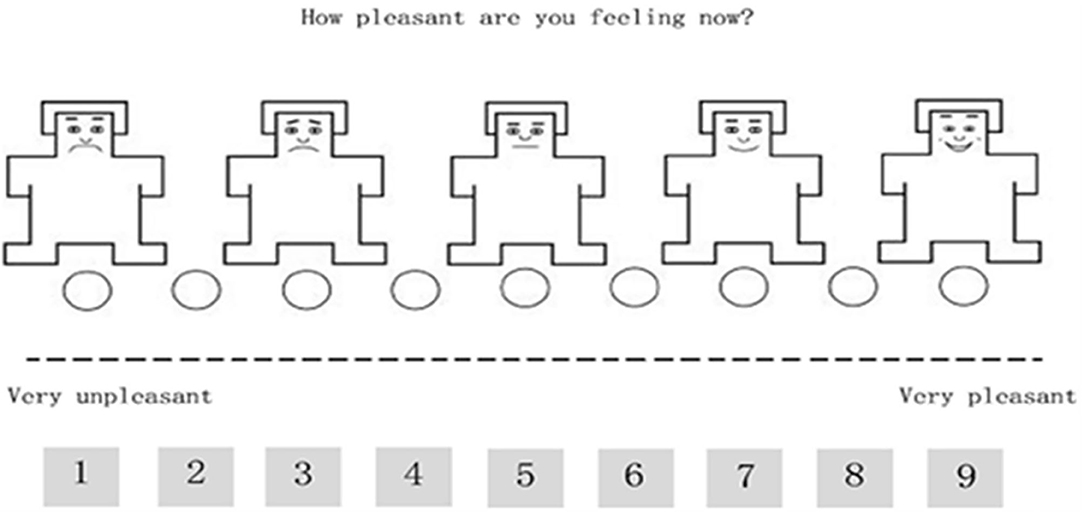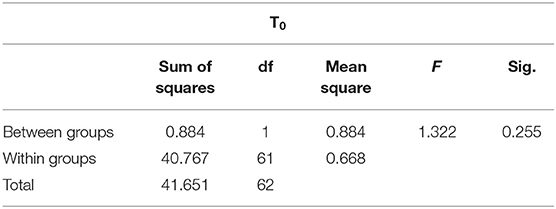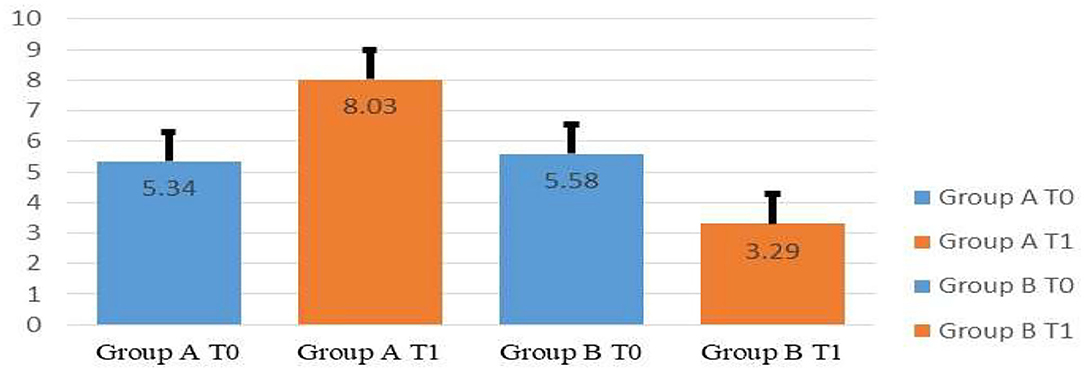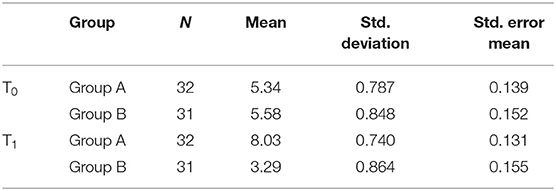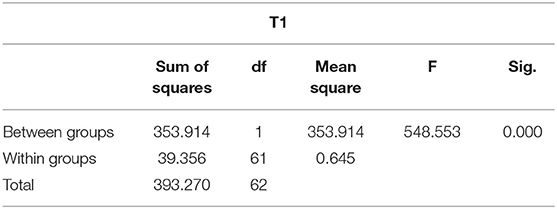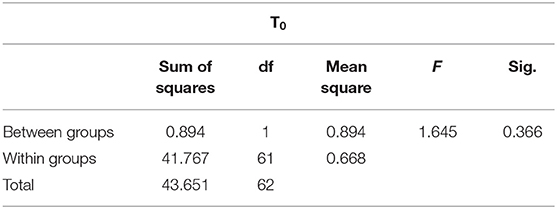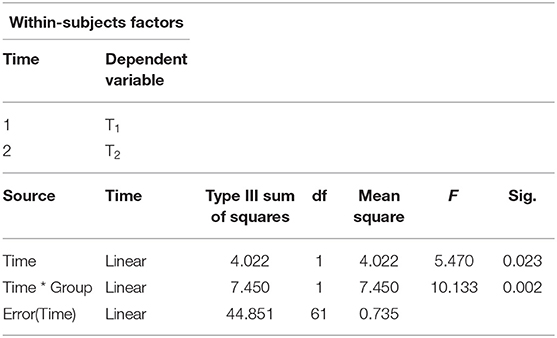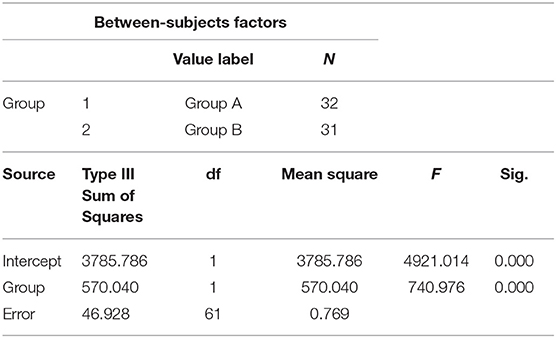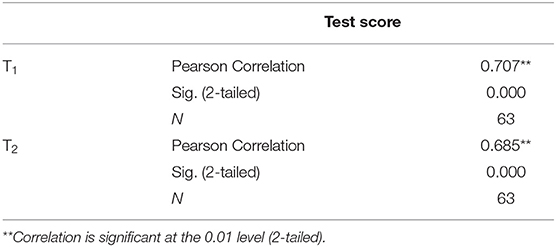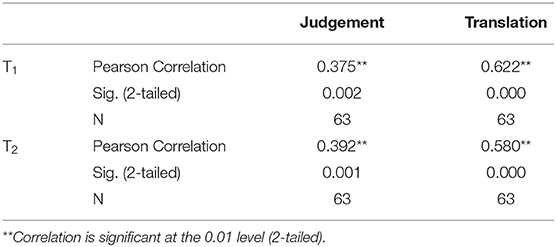- 1Foreign Language School, Guangxi Medical University, Nanning, China
- 2School of Business, Wenzhou University, Wenzhou, China
As English plays a significant role in most professions, improving the English for Specific Purpose (ESP) writing competence allows individuals to participate in the global professional community, which makes ESP writing important for research. However, research on ESP writing is reported to be insufficient, and how factors such as emotions affect ESP writing is rarely and marginally studied. Therefore, this study aimed at investigating how induced emotions influence the learning outcome in ESP writing classes with an emphasis on a particular rhetorical choice among medical university undergraduates. A total of 63 medical university undergraduates were recruited. After the emotional inducement, they were taught with materials selected and adopted from the BioCauses corpus and with an explicitly inductive teaching approach. Results revealed that positive emotions positively correlated with better learning outcomes, while negative emotions hindered participants in their learning. The results shed light on the impact of emotional states on ESP/medical research article (MRA) writing, learning, and teaching. Further study implications were provided accordingly.
Introduction
English “plays a significant role in most professions but perhaps nowhere more so than in medicine, where effective communication is widely recognized as important to clinical outcomes” (Paltridge and Starfield, 2013, p. 243). English communication is also important, for example, for revealing the causes of diseases as well as healing or to exchange novel research findings. Publishing medical research articles (MRAs) in English, therefore, has become the most essential and prestigious tool for professionals to communicate within the medical academic community and to convey novel research findings to a wider world (Swales, 1990; Reimerink, 2006). Also, it is well-recognized that teaching English for Specific Purpose (ESP) writing should not merely control linguistic errors, but also make it become a suitable genre to respond to contexts and practices (Paltridge and Starfield, 2013). Thus, teaching ESP for MRA writing should focus on guiding students toward writing competence regarding particular targets and writing styles. Among many factors that influence the quality of MRAs, causality relations are vital regarding the characteristics and goals of MRAs, namely, discussing and explaining mechanisms, rationales, and principles behind medical research, pharmacological effects, disease healing, and prevention (The Lancet, 2013; Hudzik, 2016). Cao et al. (2018) proposed that cause-effect statements cover about 65% of medical-related articles on average. In addition, distinctive differences in linguistic choices can be found in English academic writing for particular purposes and readers (Paltridge and Starfield, 2013). Thus, guiding medical university students to express causality relations by using MRAs' particular rhetorical choice is indispensable for helping them improve their MRA writing competence to produce adequate articles that respond to the medical contexts.
Pekrun and Linnenbrink-Garcia (2012) stated that “emotions are ubiquitous in academic settings” (p. 259), and it is well-recognized that emotion has a profound effect on language learning (Pekrun et al., 2002; Linnenbrink, 2006; MacIntyre and Gregersen, 2012; Pishghadam et al., 2016). The Affective Filter Hypothesis proposed by Dulay and Burt (1977) also indicates that various affective variables are highly related to foreign language acquisition by either facilitating or hindering the success of acquiring a second language. Besides, numerous studies show that emotions play an influential role in specific areas of foreign language learning, such as semantics, syntax, and language comprehension (Vissers et al., 2013; Liu et al., 2018). However, the influence of emotions on the learning outcome in ESP writing classes, which are intended to improve students' competence especially in MRA writing by understanding and learning the usage of specific linguistic signals to achieve a specific purpose, has remained marginally researched.
Thus, the purpose of this study was to fill this gap by investigating and answering the research question: How do emotions influence the learning outcomes in ESP writing classes with an emphasis on specific linguistic signals functioning as the causality relation markers in MRAs among medical university students? Also, this study aims to provide implications for teaching and future research in accordance with the research findings.
Literature Review
The Importance of Causal Relations in MRAs
MRAs are formal, rigorous, and scientific texts that require logical structure, coherence, and structural integrity. Cause-effect relations play an essential role in cohering and representing the core of MRAs (Cao et al., 2018). Furthermore, causality relations function as essential and fundamental relations, because they explain the functioning and mechanisms explored by researchers after observing phenomena, conducting experiments, suggesting treatments, or giving diagnoses. Furthermore, causality relations allow research peers, professionals, and other related personnel to distill essential information and novel knowledge from those articles (Mihăilă and Ananiadou, 2014). This is very helpful for readers to increase reading speed, recall contents, and identify events with higher importance, which significantly reduces the workload of research peers in cohering and understanding the core information of MRAs (Cao et al., 2018). Thus, causality relations play an essential role in constructing MRAs to convey their core information.
Verbs+That-Clauses as the Markers of Causality Relations in MRAs
Causality relations can be conveyed in many ways, and “causal markers are both highly ambiguous and highly variable” in MRAs (Mihăilă and Ananiadou, 2014, p. 24). The tokens with causal meanings such as conjunctives (e.g., because, since), adverbs (e.g., therefore, hence), and prepositions (e.g., because of, due to) can be adopted to mark causality relations (Mo, 2015) [see (1)].
(1) This acid pH-promoted increase appears to be specific to a subset of PhoP-activated genes (our unpublished results) that includes pmrD because expression of the PhoP-regulated slyA gene and the PhoP-independent corA gene was not affected by the pH of the medium.
(Perez and Groisman, 2007).Tokens which have no causal meaning can also be employed to convey causality relations. For instance, in sentence (2), the causality relation that SPI-2 genes can be activated because “SsrB binds within SPI-2” is triggered by the word “and,” which possesses non-causal meaning.
(2) SsrB binds within SPI-2 and activates SPI-2 genes for transcription.
(Mihăilă and Ananiadou, 2014, p. 2)Apart from those two categories of words that belong to the group of close-class words, syntactic markers with words that belong to the group of open-class words, such as verbs+that-clauses, are “more commonly used as causal [markers]” (Mihăilă and Ananiadou, 2014, p. 2). This is evidenced by the results provided by Mihăilă and Ananiadou (2014) obtained by analyzing the frequency of syntactic markers and verbs+that-clauses in the BioCause corpus. As causality is at the heart of medical knowledge, the BioCause corpus annotated with approximately 850 causality relations from open-access, full-text, medical-related journal articles published in the years 2012 to 2018. According to their findings, such syntactic causality markers occupied more than 70% of the total causality relations annotated.
In sentences (3) and (4), “suggesting that” and “suggested that” indicate the causality relations as in the examples. Although the syntactic markers “suggesting that” and “suggested that” do not bear causal meaning (Mihăilă and Ananiadou, 2014), the causality relations are conveyed, and sentences (3) and (4) can be rephrased as (3') and (4'), respectively.
(3)…location of binding sites varies, suggesting that SsrB regulation is unusual.
(3') rephrased: …since location of binding sites varies, SsrB regulation is unusual.
(Yoon et al., 2009)(4) …DNA disrupted the integrity of the cell envelope causing cell lysis suggested that DNA was acting as a cation chelator.
(4') rephrased: …because DNA disrupted the integrity of the cell envelope which caused cell lysis, DNA could act as a cation chelator.
(Mulcahy et al., 2008)It can be discovered based on the above-mentioned examples that verbs+that-clauses can function either as verbs or -ing adjuncts in sentences when conveying causality relations (Mihăilă and Ananiadou, 2014). Such relations are commonly and largely used when explaining hidden principles or mechanisms in results and discussion sections of MRAs. Therefore, in this study, sentences that employ verbs+that-clauses to convey causality relations in all result and discussion sections annotated in the BioCause corpus are analyzed. Words used and their frequency are shown in Figure 1.
It can be found from Figure 1 that the verbs “suggest” and “indicate” were most commonly used, and other verbs with similar meanings and functions were also employed. Researchers such as Liu and Braine (2005), Mo (2015), and Chen (2019) asserted that in comparison to essays written by English native speakers, Chinese learners who learn English as a foreign language tend to misuse and overuse causal markers. Furthermore, Chinese medical university undergraduates scarcely used verbs+that-clauses to convey causality relations. Hence, it is vital and indispensable to assist medical university students who desire to join the professional community by publishing sound research articles in English in international medical-related journals in being proficient in adopting specific rhetorical choices to express causality relation, such as verbs+that-clauses, to produce adequate MRAs.
Research on ESP Writing and the Influence of Emotions on Language Learning
“In recent years, the field of ESP has become increasingly sensitive to the ways in which texts are written and responded to by individuals acting as members of social groups” (Paltridge and Starfield, 2013, p. 96). However, most of the research on ESP writing mainly focuses on business writing. The studies on English writing for medical purpose (EMP) is either being ignored (Su et al., 2022) or mainly about genres, terminology, hedges, and if-conditional structures (Paltridge and Starfield, 2013). Studies about the impact of other factors such as emotions on ESP, especially on EMP writing, are rare. Although the impact of emotions on ESP learning is insufficiently studied, Flowerdew (2008) proposed that negative emotions may become the burden on the improvement of ESP writing competence.
In terms of general English learning, emotions can be very influential and pervasive during language competence development and language learning and processing (Egidi and Nusbaum, 2012; Driscoll and Powell, 2016; Tyng et al., 2017; Lindquist, 2021). Dewaele and Alfawzan (2018) explained that language learning is closely associated with students' motivation, engagement, memory, and cognitive progress, which are proved to be influenced by emotions. It is well-recognized and well-established that foreign language anxiety plays a negative role in foreign language learners' progress and performance (Liu and Jackson, 2008; MacIntyre and Gregersen, 2012; MacIntyre and Mercer, 2014; MacIntyre and Vincze, 2017; MacIntyre et al., 2019). Dewaele and Alfawzan (2018) and Bensalem (2021) further confirmed such a negative relationship between anxiety and foreign language achievement. Besides, by analyzing a group of 189 foreign language pupils and 152 English learners and users in Saudi Arabia, they discovered that better test results were obtained when students had higher levels of enjoyment in foreign language classes.
Apart from the discussed research, studies concerning subtypes of linguistic knowledge were conducted. Li and Wei (2022) found that enjoyment can be the strongest emotional factor that helped researcher predict English learners' positive achievement by observing 954 learners. However, contrary to the general agreement that positive emotions are associated with better foreign language learning outcomes, the findings of those studies are inconsistent. To be more precise, Pratt and Kelly (2008) examined the effects of emotions on lexical learning and proposed that “people process affective language differently when in positive and negative moods, and lend support to [their position] that emotion and cognition interact during language comprehension” (p. 434). From electroencephalography (EEG) experiments, researchers such as Egidi and Nusbaum (2012), Van Berkum et al. (2013), Egidi and Caramazza (2014), and Lindquist (2021) found that emotions could change real-time language processing, and positive mood seemed to activate referential anticipation that benefited the improvement of reading comprehension, while bad mood abolished such anticipation. Vissers et al. (2010) and Verhees et al. (2015) examined the interaction between syntactic processing and induced emotions (happy vs. sad) by recording event-related potentials and comparing the P600 (the peak in electrical brain activity, which is measured by EEG) effects with subject-verb agreement. The findings revealed that happy emotions were positively related to subject-verb syntactic processing, while bad emotions had a negative influence on the efficacy of processing subject-verb agreement. Vissers et al. (2013) proved that individuals with induced happy emotions performed better on semantic comprehension than the participants with sad emotions. However, Jimenez-Ortega et al. (2012) argued that the happy mood failed to outweigh the other in both semantic and syntactic experiments, which means that higher error rates were found when participants had positive conditions rather than negative emotional conditions. Liu et al. (2018) employed pictures and music that could induce positive emotions (happy) and negative emotions (sad) before teaching Japanese morphosyntax to undergraduates who had not learnt this linguistic aspect previously. The results revealed that when learning Japanese morphosyntax, the induced negative emotions (sadness) increased the accuracy and efficiency of Japanese syntax learning. However, they asserted that such results could not be generalized.
Although there are incompatible research findings and a lack of research on relations between emotions and ESP learning, especially EMP writing competence and, as the research discussed above shows, it is unclear whether those findings, especially the effects of emotions on grasping specific linguistic signals and forms, can be generalized. Numerous studies support the position that positive emotions promote positive language learning outcomes. Hence, it was reasonable to predict that emotional conditions also influence the understanding and learning of verbs+that-clauses as the specific linguistic markers of causality relations in MRAs, and positive emotions would facilitate such learning. If so, it was reasonable to hypothesize that better teaching outcomes could be obtained through employing emotion manipulation as the strategy in actual teaching of MRA writing, suggesting that the evaluation and examination of emotional effects on such learning are demanding.
Therefore, to fill the gap, this study conducts research on the effects of induced emotions on the learning of one of the most-commonly used MRAs' causality relation markers (i.e., verbs-that-clauses), referring to their research design.
Methods
Participants
In this research, 63 Chinese native medical university undergraduates in the third academic year were recruited. The research advertisement was released by English teachers of the university, and the participants aged 19–21 years (mean = 19.44; SD = 0.69) took part. After getting the consent forms from all participants, they were randomly divided into two induced-emotion groups: 32 for positive (Group A) and 31 for negative emotions (Group B). Gender distribution (total female: 51.6%; total male: 46.9%) was quite similar across the groups: 17 women and 15 men in Group A, and 16 women and 15 men in Group B. According to the English Curriculum Requirements for non-English major undergraduate students (The Ministry of Education, China, 2020), English is a required subject for all non-English major undergraduate students, and the students took the 45-min English class four times a week. Their English proficiency was evaluated with their scores on the final English exam of the previous semester. Results showed that there was no statistically significant difference (p = 0.781). They all passed College English Test (Band 4), which demonstrated that their general English competence was medium or advanced. An extra translation exam (Appendix 1) was employed to test whether the participants are aware of verbs+that-clauses as causality markers. The results showed that no significant difference was found (p = 0.41) among the participants, and they achieved very low scores, indicating that they did not have full understanding and awareness of adopting the target structure to convey causality relations in MRAs.
Research Design, Materials, and Procedure
Research Design
Referring to the study conducted by Liu et al. (2018) and Li and Wei (2022) and considering the purpose of this study, i.e., to explore the effect of emotions on the learning outcomes with an emphasis of a specific rhetorical linguistic signal of casual relations (verbs+that-clauses) in MRAs, this study includes the following steps (Figure 2): 1. Emotional inducement: induced positive emotion (happy) and negative emotion (sad); 2. Learning task: imparted target rhetorical structures and their purpose; and 3. Testing task: tested learning outcomes.
The learning task was designed with the aim that the participants were trained to understand and learn the usage of target clauses/structures to convey causality relations in MRAs, while the testing task was devised to measure the learning outcomes. Both types of tasks were administrated by the same English teacher via the EMP writing training section (~100 min, time for emotion inducement included). Participants' learning outcomes were measured immediately after the treatment via “translation” and “judgement” tests (refer to Appendix 2, examples). The reliability and the validity of the final tests were tested in advanced and were 0.87 and 0.78, respectively.
Research Materials
Two funny and two sad Chinese video clips between 3 and 5 min in length, as well as 20 funny and 20 sad pictures were employed to induce participants' cheerful (positive) and sad (negative) emotions, respectively. For instance, for inducing the cheerful emotions, the video clip that shows cute dogs was shocked by their owners. Then, the Self-Assessment Manikin (SAM) pictorial rating scale, which also measures arousal and dominance (Bradley and Lang, 1994), was employed to measure participants' emotions, and it has been proved to possess high reliability and validity regarding measuring emotional responses in various situations, including reactions to pictures (Greenwald et al., 1989; Lang et al., 1993; Bradley and Lang, 1994; Geethanjali et al., 2017) and videos (Bradley and Lang, 1994). Due to the aims of this study, only the valence SAM with the 9-point scale (Figure 3) was used.
As writers employ distinctive rhetorical differences for different purposes when writing academic texts in English, authentic and specific articles or writing examples should be utilized to gain an understanding of how professionals communicate and present their research findings effectively and strategically (Liu and Braine, 2005; Lei, 2012; Paltridge and Starfield, 2013). In addition, ESP/EMP articles are always a response to particular readers in particular academic settings, which requires its linguistic choices and forms to serve a specific purpose (Paltridge and Starfield, 2013). The published MRAs can therefore become sound teaching materials, containing commonly used and particular linguistic items as well as rhetorical choices. For this reason, the teaching materials used for this study were obtained from the BioCause corpus. The annotation principle employed by the experts who generated BioCause is shown in Figure 4.
Research Procedure
Emotion Induction and Measurement
The pre-test of the target structure was given to make sure that all students had the same knowledge of the target structure to ensure that they would not be misled. Emotion induction was conducted once, and participants' emotional conditions were measured three times via the SAM. Higher scores represented higher emotional valence. Participants' emotional conditions were measured before (T0) and after showing the video clips and pictures (T1) to participants in two groups to examine whether the inducement worked effectively. It was measured again before taking the test (T2) to test whether the learning activities influenced their emotional status.
The Learning Task
The participants were divided into two groups and the same teaching approaches were adopted by the same teacher in both the groups with the aim that other influential variables can be eliminated to a certain degree. More precisely, the explicitly inductive approach (DeKeyser, 2008) to target knowledge teaching was employed. Eleven sentences with verbs+that-clauses that convey causality relations were obtained from BioCause and were used as the teaching materials. During the first teaching phase, participants were required to observe some non-medical sentences with simple words, using verbs+that-clauses as well as other causal markers (e.g., conjunctives, adverbs, and prepositions) to convey causality relations. The differences and similarities were compared in a discussion. The participants were then required to observe six sentences that were obtained from the BioCause corpus and their reworded counterparts with conjunctives, adverbs, and prepositions (e.g., since, therefore, because) on hand-outs. The teacher guided participants in analyzing sentences to tell differences and similarities between the original and reworded sentences by drawing Venn diagrams. Also, they received assistance in understanding the meaning of the sentences (medical terms were translated into Chinese), listing the causes and effects described in each sentence. Later, the structure rules and their functions were taught explicitly by the teacher. In the second phase, participants were provided with the rephrased version (the original verbs+that-clauses were replaced by conjunctives, including “since,” “because,” and “as”) of the remaining five sentences. Then, they were instructed to rewrite those sentences using verbs+that-clauses, which had been learnt during the first phase. Later, they were offered the original sentences and were required to work in groups to discuss whether they got the correct answers (verbs can be used interchangeably).
The Testing Task
In the phase of testing, sentence translation and Yes-No (YN) judgment tasks were devised to test learning outcomes right after the teaching finished. In the YN task, participants were required to judge whether verbs+that-clauses in the 10 given sentences functioned as causality markers following the judgment task step proposed by Schütze and Sprouse (2014). Such tests are aimed at measuring whether participants establish the awareness of using verbs+that-clauses to mark causality relations in MRAs. In the translation task, 10 sentences had to be translated from Chinese to English using the taught verbs+that-clauses (verbs could be used interchangeably). This task was designed to mainly test whether the participants grasped the grammatical rules and functions of verbs+that-clauses. In doing so, teacher could examine students using the phrases to express casual relations and whether they can produce the correct patterns. The full mark of the test was 20, and three English teachers, who have been teaching in the medical university for more than 8 years, were invited to cross-rate the tests.
Results
Data were analyzed by employing IBM SPSS Statistics 24, and the significance level was set at 0.01.
Emotional Inducement
Table 1 summarizes the rating of the initial emotional conditions of the two groups. No significant difference was detected between the two groups before emotion induction, which means that all participants had a similar emotion status (p = 0.255).
After the treatments, the results of the t-test analysis revealed that the emotional valence of participants of Groups A and B differed significantly, which means that the approach of inducing emotion was effective (t-test results: refer to Figure 5 and Tables 2A,B). Furthermore, the analysis of variance (ANOVA) (Table 3) showed that, after the emotion induction, a significant difference could be observed between the two groups (p = 0.00), which further indicates that the emotion induction achieved the anticipated goal. Further correlation analysis was conducted to examine whether the inducement may have difference effect between female and male students. The data suggested that female students' and male students' emotional valence had no significant difference (p > 0.05) after conducting emotional inducement (Table 3B).
To explore whether the effect of the emotional induction was sustained, and the teaching method influenced participants' emotions, repeated-measures ANOVA was performed, setting the time (second vs. third) as the within-subject variable and the group (Group A vs. Group B) as the between-subjects variable (Tables 4A,B). The results indicate that emotional conditions did not differ significantly after the verbs+that-clauses were taught (p = 0.023). The participants of Group A still possess higher emotional valence than those of Group B, and significant differences existed (p = 0.00). The results prove that the effect of emotion induction was sustained in a stable way throughout the learning period, and there was no significant influence of time or the employed teaching method on the participants' emotional conditions.
The Effect of Emotions on Verbs+That-Clauses Causality
Participants' learning outcomes were measured by t-test analysis to primarily test whether positive emotions (happy) facilitated the target structure learning and its function in understanding MRAs, i.e., whether participants of Group A achieved better learning outcomes, as assumed. The t-test analysis showed that test scores obtained after the treatments by the participants of Group A (mean = 18.38; SD = 1.238) were higher than those of Group B (mean = 15.71; SD = 1.596), and significant differences were observed (p = 0.00) (Tables 5A,B).
To investigate the relationship between positive emotion (happy) and negative emotion (sad) and the learning outcomes, the Pearson correlation analysis and regression analysis were conducted. The Pearson correlation analysis evidences the high degree of positive relation between positive emotion conditions and better test results (r = 0.707, p = 0.000). In other words, higher levels of positive emotions can trigger better learning outcomes (Table 6).
To further demonstrate the impact of emotions on the target English structure and its functions' learning outcomes, a regression analysis was conducted. The result also revealed that more favorable learning outcomes were achieved by participants in positive emotion (happy) conditions (Tables 7A,B).
The Pearson correlation analysis was conducted to further explore the relationship between emotion conditions (happy vs. sad) and the outcomes of two testing tasks, translation (r1) as well as judgment (r2), as these two testing types reflect whether participants understand the syntactic structures and grasp the awareness of using such structures in marking causality relations in MRAs. The results (Table 8) illustrate that the correlation between positive emotion and translation (r1 = 0.622) is slightly stronger than the one between higher emotional valence and better judgment results (r2 = 0.375). However, there is no significant difference between the two correlation coefficients (p = 0.0673), which means that although the r1 is slightly higher than r2, the extent of the effect of emotion on completing different types of testing tasks did not differ significantly.
Discussion and Implications
This study explores the effect of induced positive emotion (happy) and negative emotion (sad) on the understanding and learning of verbs+that-clauses, which are commonly used as the specific rhetorical choices to mark causality relations in MRAs (Mihăilă and Ananiadou, 2014). In particular, an explicitly inductive approach was employed, authentic teaching materials were selected from the BioCause corpus, and the influence of induced positive (happy) and negative (sad) emotions was investigated by employing translation as well as judgment tasks as testing methods.
Following the research design, participants' positive and negative emotions were first induced with happy and sad Chinese video clips and pictures and measured by employing the 9-point SAM scale. The results demonstrate that the emotional manipulation was successful. After the emotion induction, the teacher assisted participants in understanding and learning the structures with which causality relations were conveyed, using authentic teaching materials selected from the BioCause corpus. Correlation and regression analyses revealed the positive correlations between positive emotions (happy) and the tests results. Thus, it is fair to assert that positive emotions can facilitate and be positively associated with the understanding and learning of verbs+that-clauses as causality markers in MRAs. The results are in line with the positions of many researchers that were mentioned in the literature review as well as the initial prediction that such a learning purpose can be enhanced by positive emotions (happy).
Besides, more explanations support the findings. Positive emotions enhance EFL leaners' abilities to notice knowledge they are learning in classrooms and “become more aware of language input,” while “negative emotions can cause narrowing of focus and limit the potential language input” (Dewaele and Alfawzan, 2018, p. 26). Also, Dewaele and Alfawzan (2018) proffered that positive emotions make “students more resilient and hardy during difficult time” (p. 26). Since the results show that the ultimate emotion conditions of two groups' participants did not differ significantly from the induced ones, their emotion conditions remained happy and sad, respectively, during the learning. Sad participants may not be able to accept knowledge input fully and comprehensively. They might not be optimistic either when encountering difficulties while completing the learning tasks. Thus, this finding can support the position that MRA writing competence in terms of using a particular syntactic structure to mark causality relations can be enhanced when medical undergraduates are in positive emotional conditions. When guiding ESP writing, emotion manipulation strategies are therefore recommended for better learning and teaching outcomes.
Results can also be explained based on the Positive Psychology (PP), one of whose aims is to increase learners' wellbeing and positive mental condition. Many research-supported PP-based teaching activities that are employed to encourage learners to flourish inside thereby improving their linguistic and communicative competences and proficiency. By triggering learners' positive mental conditions and health through letting them feel cheerful, students can enhance the “input” and consolidate and store long-term memories about the “input language knowledge” more easily. This is because learners are beneficial from positive psychology, which allows them to tackle emotional overload, develop resistance, and become more optimistic toward the learning outcomes.
For implications, to successfully manipulate the emotions of students, the cultural background, and social contexts, which are influential for the emotion inducement, need to be considered when selecting materials. In this study, the participants in Group A showed much higher emotional valence than participants of the negative emotion group after watching funny and sad Chinese video clips and pictures that could effectively trigger their emotional empathy. Unlike using pictures or video clips in this study, Liu et al. (2018) employed the music “Brandenburg Concerto” as the positive emotion trigger and “Alexander Nevsky: Russian under the Mongolian Yoke” as the negative emotion trigger in their study. Their musical inducement was reported to be not effective, as Chinese participants were not familiar with the music. Thus, culturally and social contextually appropriate materials are recommended to ensure the inducement triggers the anticipated emotions when teaching in different conditions.
Besides, contrary to the results of this study, Liu et al. (2018) suggested that positive-emotion learners, who learnt Japanese morphosyntax, did not perform better than negative-emotion learners. Contrary to the findings of the present research, their negative learners achieved better learning outcomes. According to their explanation, this is because negative-emotion leaners were more motivated to achieve the expected learning goals and were more realistic about the gap between their abilities and desired learning outcomes. Therefore, more studies are necessary to explore whether emotions' effects vary greatly between languages or language areas (e.g., verbs, sentence structure, and morphosyntax). However, with the similar teaching goals, i.e., improving ESP/EMP learning outcomes regarding the writing strategies by using specific linguistic signals in ESP/EMP writings.
In terms of the teaching method, the explicitly inductive approach was used to target ESP writing knowledge teaching in this study. Positive emotions are reported to be highly linked to cognitive perspectives, which intertwined with understanding and mental processes, including memory, thinking, and problem solving (Ashby and Isen, 1999; Winn, 2013). Moreover, Vissers et al. (2013) purported that “positive [emotions] validate[s] accessible cognition and leads to a more [specific to global] category processing of information” (p. 1,027), and such a cognitive process is associated with inductive learning, which is also supported and enhanced by positive emotions (Liu et al., 2018). Therefore, whether to conduct emotional manipulation, whether it could work effectively, and what types of emotions can stimulate better learning outcomes is highly associated with the employed teaching method. This study proves that higher emotional valence is recommended to be triggered when adopting such an explicative specific-general teaching approach, i.e., explicatively inductive teaching procedure. This way, students are led to inductively learn the structure and its functions first, and they are then provided with formulated rules to the applications in practical language use.
Finally, the correlation analyses were conducted to detect the relationships between emotions and results of two types of testing tasks. Both results revealed a positive relationship, and the correlation between emotion and the translation test results (r1) is slightly stronger than the one between emotion and judgment test results (r2). The initial purpose of the analysis was to examine whether the emotion as well as the teaching methods affect students' linguistic structure learning differently and establish awareness of employing particular rhetorical choices for MRAs writing. Although structural learning seemed to relate more closely to positive emotional conditions, there was no statistically significant difference. This result, however, cannot be considered robust evidence for the position that positive emotional conditions made more contributions to the structural learning, and the effects of emotions on the cognitive process of completing different test tasks do not vary. One possible explanation may be that participants' professional knowledge was not sufficient to connect extra textual inferences when judging whether the verbs+that-clauses marked cause and effect relations in YN judgement tasks. Looking at Q5 (5) as an example shows that (5') is the original sentence selected from the BioCause corpus, and the causality relation was conveyed by “because”. In the judgment test, some participants marked “x,” meaning the “suggested that” clause did not mark causal relations, which is proved to be incorrect. More studies are required to discover the mechanisms behind such relations, and to what extent emotions affect test takers' performance on different categories of ESP learning tasks.
Conclusion
In ESP writing training, teachers should not merely focus on imparting linguistic knowledge, but also guide students in learning the usage of particular rhetorical choices to communicate effectively and strategically in corresponding fields. However, research on ESP writing is insufficient, and how factors such as emotions affect ESP writing is rarely and marginally studied. Thus, this study examines the influence of induced emotions (happy vs. sad) on the learning outcomes of ESP writing classes with emphasis on the verbs+that-clauses functioning as causality relation markers in English MRAs among Chinese medical university undergraduates. To be specific, 63 volunteers participated, and published MRAs obtained from the BioCause corpus were employed as the teaching materials. After the emotion inducement and teaching with an explicitly inductive approach, their emotion status and learning outcomes were measured and analyzed using the ANOVA and t-test. The results proved the success of emotion inducement. The correlation analyses revealed the positive relationships between positive emotions and better learning outcomes, suggesting positive emotions can enhance and facilitate the understanding and learning of verbs+that-clauses as the causal relation markers in MRAs. Based on the findings, some implications were provided.
However, some limitations still exist. First, this study only tested the emotions on understanding and learning of verbs+that-clauses in MRAs to convey causality relations, and the results may not be generalizable for ESP/EMP writing training as a whole. More studies are necessary for discovering the correlation between emotions and the learning of other categories of English knowledge. The test methods adopted in this study only examined the immediate learning outcomes, and long-term effects should also be explored. Second, this study only focused on medical university graduates.
Hopefully, further research could focus on and expand the findings of this study to explore the interplay between emotions and other categories of knowledge in ESP/EMP. Despite the limitations, the results shed light on the impact of emotional states on ESP/MRA writing, learning and teaching, and the implications of this study can be referred among the similar teaching and learning conditions.
Data Availability Statement
The raw data supporting the conclusions of this article will be made available by the authors, without undue reservation.
Ethics Statement
The studies involving human participants were reviewed and approved by Guangxi Medical University Ethics Committee. The patients/participants provided their written informed consent to participate in this study. Written informed consent was obtained from the individual(s) for the publication of any potentially identifiable images or data included in this article.
Author Contributions
All authors listed have made a substantial, direct, and intellectual contribution to the work and approved it for publication.
Conflict of Interest
The authors declare that the research was conducted in the absence of any commercial or financial relationships that could be construed as a potential conflict of interest.
Publisher's Note
All claims expressed in this article are solely those of the authors and do not necessarily represent those of their affiliated organizations, or those of the publisher, the editors and the reviewers. Any product that may be evaluated in this article, or claim that may be made by its manufacturer, is not guaranteed or endorsed by the publisher.
Supplementary Material
The Supplementary Material for this article can be found online at: https://www.frontiersin.org/articles/10.3389/fpsyg.2022.909590/full#supplementary-material
References
Ashby, F. G., and Isen, A. M. (1999). A neuropsychological theory of positive affect and its influence on cognition. Psychol. Rev. 106, 529. doi: 10.1037/0033-295X.106.3.529
Bensalem, E. (2021). Classroom enjoyment and anxiety among Saudi undergraduate EFL students: does gender matter? Vigo Int. J. Appl. Linguist. 18, 9–34. doi: 10.35869/vial.v0i18.3363
Bradley, M. M., and Lang, P. J. (1994). Measuring emotion: the self-assessment manikin and the semantic differential. J. Behav. Ther. Exp. Psychiatry 25, 49–59. doi: 10.1016/0005-7916(94)90063-9
Cao, M., Sun, X., and Zhuge, H. (2018). The contribution of cause-effect link to representing the core of scientific paper—the role of Semantic Link Network. PLoS ONE 13, e0199303. doi: 10.1371/journal.pone.0199303
Chen, Q. (2019). Theme-Rheme structure in Chinese doctoral students' research writing—from the first draft to the published paper. J. English Acad. Purposes 37, 154–167. doi: 10.1016/j.jeap.2018.12.004
DeKeyser, R. (2008). “11 Implicit and explicit learning,” in The Handbook of Second Language Acquisition. Vol. 27, eds C. J. Doughty and M. H. Long (Wiley-Blackwell), 313.
Dewaele, J. M., and Alfawzan, M. (2018). Does the effect of enjoyment outweigh that of anxiety in foreign language performance? Stud. Second Lang. Learn. Teach. 8, 21–45. doi: 10.14746/ssllt.2018.8.1.2
Driscoll, D. L., and Powell, R. (2016). States, traits, and dispositions: the impact of emotion on writing development and writing transfer across college courses and beyond. Composition Forum 34.
Dulay, H., and Burt, M. (1977). Remarks on creativity in language acquisition. Viewpoints English Second Lang. 2, 95–126.
Egidi, G., and Caramazza, A. (2014). Mood-dependent integration in discourse comprehension: happy and sad moods affect consistency processing via different brain networks. Neuroimage 103, 20–32. doi: 10.1016/j.neuroimage.2014.09.008
Egidi, G., and Nusbaum, H. C. (2012). Emotional language processing: how mood affects integration processes during discourse comprehension. Brain Lang. 122, 199–210. doi: 10.1016/j.bandl.2011.12.008
Flowerdew, J. (2008). Scholarly writers who use English as an additional language: what can Goffman's “Stigma” tell us? J. English Acad. Purposes 7, 77–86. doi: 10.1016/j.jeap.2008.03.002
Geethanjali, B., Adalarasu, K., Hemapraba, A., Pravin Kumar, S., and Rajasekeran, R. (2017). Emotion analysis using SAM (Self-Assessment Manikin) scale. Biomed. Res. 28.
Greenwald, M. K., Cook, E. W., and Lang, P. J. (1989). Affective judgment and psychophysiological response: dimensional covariation in the evaluation of pictorial stimuli. J. Psychophysiol. 3, 51–64.
Hudzik, B. (2016). What makes a good medical journal great? Can. Med. Assoc. J. 188, 531. doi: 10.1503/cmaj.1150100
Jimenez-Ortega, L., Martín-Loeches, M., Casado, P., Sel, A., Fondevila, S., De Tejada, P. H., et al. (2012). How the emotional content of discourse affects language comprehension. PLoS ONE 7, e33718. doi: 10.1371/journal.pone.0033718
Lang, P. J., Greenwald, M. K., Bradley, M. M., and Hamm, A. O. (1993). Looking at pictures: affective, facial, visceral, and behavioral reactions. Psychophysiology 30, 261–273. doi: 10.1111/j.1469-8986.1993.tb03352.x
Lei, L. (2012). Linking adverbials in academic writing on applied linguistics by Chinese doctoral students. J. English Acad. Purposes 11, 267–275. doi: 10.1016/j.jeap.2012.05.003
Li, C., and Wei, L. (2022). “Anxiety, enjoyment, and boredom in language learning amongst junior secondary students in rural China: How do they contribute to L2 achievement?,” in Studies in Second Language Acquisition (Cambridge Core). doi: 10.1017/S0272263122000031. Available online at: https://www.cambridge.org/core/journals/studies-in-second-language-acquisition/article/anxiety-enjoyment-and-boredom-in-language-learning-amongst-junior-secondary-students-in-rural-china-how-do-they-contribute-to-l2-achievement/B9198349C1D64B59AB1530F5ACF5721B (accessed March 13, 2022).
Lindquist, K. A. (2021). Language and emotion: introduction to the special issue. Affect. Sci. 2, 91–98. doi: 10.1007/s42761-021-00049-7
Linnenbrink, E. A. (2006). Emotion research in education: theoretical and methodological perspectives on the integration of affect, motivation, and cognition. Educ. Psychol. Rev. 18, 307–314. doi: 10.1007/s10648-006-9028-x
Liu, M., and Braine, G. (2005). Cohesive features in argumentative writing produced by Chinese undergraduates. System 33, 623–636. doi: 10.1016/j.system.2005.02.002
Liu, M., and Jackson, J. (2008). An exploration of Chinese EFL learners' unwillingness to communicate and foreign language anxiety. The Modern Language Journal 92, 71–86. doi: 10.1111/j.1540-4781.2008.00687.x
Liu, X., Xu, X., and Wang, H. (2018). The effect of emotion on morphosyntactic learning in foreign language learners. PLoS ONE 13, e0207592. doi: 10.1371/journal.pone.0207592
MacIntyre, P., and Gregersen, T. (2012). Emotions that facilitate language learning: the positive-broadening power of the imagination. Stud. Second Lang. Learn. Teach. 2, 193–213. doi: 10.14746/ssllt.2012.2.2.4
MacIntyre, P. D., Gregersen, T., and Mercer, S. (2019). Setting an agenda for positive psychology in SLA: theory, practice, and research. Modern Lang. J. 103, 262–274. doi: 10.1111/modl.12544
MacIntyre, P. D., and Mercer, S. (2014). Introducing positive psychology to SLA. Stud. Second Lang. Learn. Teach. 4, 153–172. doi: 10.14746/ssllt.2014.4.2.2
MacIntyre, P. D., and Vincze, L. (2017). Positive and negative emotions underlie motivation for L2 learning. Stud. Second Lang. Learn. Teach. 7, 61–88. doi: 10.14746/ssllt.2017.7.1.4
Mihăilă, C., and Ananiadou, S. (2014). Semi-supervised learning of causal relations in biomedical scientific discourse. Biomed. Eng. 13, S1. doi: 10.1186/1475-925X-13-S2-S1
Mo, J. (2015). A contrastive study of the use of causal connectives by Chinese EFL learners and English native speakers in writing. Theory Pract. Lang. Stud. 5, 2426–2432. doi: 10.17507/tpls.0511.30
Mulcahy, H., Charron-Mazenod, L., and Lewenza, S. (2008). Extracellular DNA chelates cations and induces antibiotic resistance in Pseudomonas aeruginosa biofilms. PLoS Pathogens 4, e1000213. doi: 10.1371/journal.ppat.1000213
Paltridge, B., and Starfield, S. (Eds.). (2013). The Handbook of English for Specific Purposes, Vol. 592. West-Sussex: Wiley-blackwell. doi: 10.1002/9781118339855
Pekrun, R., Goetz, T., Titz, W., and Perry, R. P. (2002). Positive emotions in education. doi: 10.1093/med:psych/9780198508144.003.0008
Pekrun, R., and Linnenbrink-Garcia, L. (2012). “Academic emotions and student engagement,” in Handbook of Research on Student Engagement eds S. L. Christenson, A. L. Reschly, and C. Wylie (Boston, MA: Springer), 259–282. doi: 10.1007/978-1-4614-2018-7_12
Perez, J. C., and Groisman, E. A. (2007). Acid pH activation of the PmrA/PmrB two-component regulatory system of Salmonella enterica. Mol. Microbiol. 63, 283–293. doi: 10.1111/j.1365-2958.2006.05512.x
Pishghadam, R., Zabetipour, M., and Aminzadeh, A. (2016). Examining emotions in English language learning classes: a case of EFL emotions. Issues Educ. Res. 26, 508.
Pratt, N. L., and Kelly, S. D. (2008). Emotional states influence the neural processing of affective language. Soc. Neurosci. 3, 434–442. doi: 10.1080/17470910802188339
Reimerink, A. (2006). The use of verbs in research articles: Corpus analysis for scientific writing and translation. New Voices Transl. Stud. 2, 9–27.
Schütze, C. T., and Sprouse, J. (2014). Judgment data. Res. Methods Linguist. 27–50. doi: 10.1017/CBO9781139013734.004
Su, S. M., Tsai, Y. H., and Tai, H. C. (2022). An ESP approach to teaching nursing note writing to university nursing students. Educ. Sci. 12, 223. doi: 10.3390/educsci12030223
Swales, J. (1990). Genre Analysis: English in Academic and Research Settings. Cambridge University Press.
The Lancet (2013). What is the purpose of medical research? Lancet 381, 347. doi: 10.1016/S0140-6736(13)60149-X
Tyng, C. M., Amin, H. U., Saad, M. N., and Malik, A. S. (2017). The influences of emotion on learning and memory. Front. Psychol. 8, 1454. doi: 10.3389/fpsyg.2017.01454
Van Berkum, J. J., De Goede, D., Van Alphen, P., Mulder, E., and Kerstholt, J. H. (2013). How robust is the language architecture? The case of mood. Front. Psychol. 4, 505. doi: 10.3389/fpsyg.2013.00505
Verhees, M. W., Chwilla, D. J., Tromp, J., and Vissers, C. T. (2015). Contributions of emotional state and attention to the processing of syntactic agreement errors: evidence from P600. Front. Psychol. 6, 388. doi: 10.3389/fpsyg.2015.00388
Vissers, C. T. W., Chwilla, U. G., Egger, J. I., and Chwilla, D. J. (2013). The interplay between mood and language comprehension: evidence from P600 to semantic reversal anomalies. Neuropsychologia 51, 1027–1039. doi: 10.1016/j.neuropsychologia.2013.02.007
Vissers, C. T. W., Virgillito, D., Fitzgerald, D. A., Speckens, A. E., Tendolkar, I., van Oostrom, I., et al. (2010). The influence of mood on the processing of syntactic anomalies: evidence from P600. Neuropsychologia 48, 3521–3531. doi: 10.1016/j.neuropsychologia.2010.08.001
Winn, W. (2013). “Cognitive perspectives in psychology,” in Handbook of Research on Educational Communications and Technology, eds J. M. Spector, M. D. Merrill, J. Elen, and M. J. Bishop (New York, NY: Springer), 90–123.
Keywords: ESP writing, emotional effects, learning outcomes, Positive Psychology, medical research articles (MRAs), university undergraduates, BioCauses corpus
Citation: Hu N and Chen M (2022) Improving ESP Writing Class Learning Outcomes Among Medical University Undergraduates: How Do Emotions Impact? Front. Psychol. 13:909590. doi: 10.3389/fpsyg.2022.909590
Received: 31 March 2022; Accepted: 13 May 2022;
Published: 20 June 2022.
Edited by:
Ruey-Shun Chen, National Chiao Tung University, TaiwanReviewed by:
Elis Kakoulli Constantinou, Cyprus University of Technology, CyprusMusa Nushi, Shahid Beheshti University, Iran
Ali Mohammad Fazilatfar, Yazd University, Iran
Copyright © 2022 Hu and Chen. This is an open-access article distributed under the terms of the Creative Commons Attribution License (CC BY). The use, distribution or reproduction in other forums is permitted, provided the original author(s) and the copyright owner(s) are credited and that the original publication in this journal is cited, in accordance with accepted academic practice. No use, distribution or reproduction is permitted which does not comply with these terms.
*Correspondence: Min Chen, eHVhbmNtQGdtYWlsLmNvbQ==
 Nan Hu
Nan Hu Min Chen
Min Chen